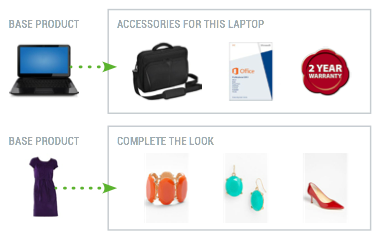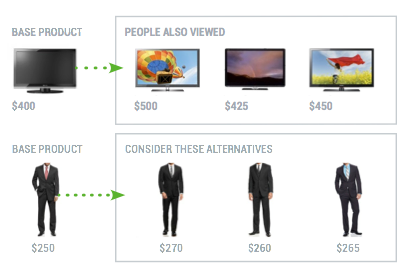Advanced Merchandising Overview
Advanced Merchandising adds an extra layer of intelligence and product knowledge to Algonomy’s personalized product recommendation solution, Recommend. Advanced Merchandising enables a superior personalization experience for the omnichannel shopper customer—combining best-in-class behavioral recommendations with attribute-based and compatibility-based tool for cross-sell and upsell.
Advanced Merchandising in Recommend provides a scalable method of managing precise cross-sell and upsell recommendations. For example, if a shopper is looking at a new television, an upsell recommendation might be the next model up while a cross-sell recommendation might include DVD players or Surround Sound systems (or both).
Advanced Merchandising can also help manage recommendations to "complete a bundle," the ability to suggest items that complement the customer’s chosen item. For example, if a customer is looking at a new digital camera, it can recommend compatible memory cards, backpacks, speedlights, filters, or lenses. Or if the shopper is looking at a jacket, Advanced Merchandising might be set up to recommend items such as a matching shirt, tie, socks, and shoes.
Using retail catalog attributes, supplemented in some cases by a built-in database of five million products and more than 100 million attributes, Advanced Merchandising gives merchants their desired level of control to curate a personalized shopping experience. Product attributes such as brand, style, dimensions, compatibility, technical specifications, pre-installed software, and manufacturer warranty information are a sample of the types of data used for personalization
Advanced Merchandising requires the product ID as the seed. As such, it works on page types with product ID and does not work on pages such as home page and category page. Also, Advanced Merchandising does not remove duplicates such as the seed product from the results list.
How It Works
Advanced Merchandising rules override the KOTH/Uber engine. Recommendation Restriction and Recommendation Boosting rules can be applied to Advanced Merchandising if the "Enable system filters and rules" option is enabled in the Advanced Merchandising rule. Using product attributes, Advanced Merchandising matches products based on rules set up by the merchandiser.
Advanced Merchandising
There are limits and high overhead to maintaining manually merchandised products. A merchandiser is not able to reach more than a small number of SKUs and it is impossible to keep up with ongoing stock churn. In addition, recommending non-compatible products can lead to dissatisfied customers and costly returns, however, merchandisers have valuable knowledge and add a lot of value to controlling recommendations. Advanced merchandising is the tool that empowers them to merchandise more of the catalog, use automated rules to save time, and automatically handle things like compatibility and stock churn.
One of the biggest challenges with manual merchandising is managing churn. On a daily basis, products are entering or going out of stock. Manual merchandising leaves recommendation slots unfilled when products go out of stock and new products either are not recommended or do not have recommendations until the merchandiser can get around to adding them. Advanced Merchandising automatically fills slots when empty or swaps in new items.
- Advanced Merchandising leverages catalog data and a drag and drop user interface to enable merchants to make custom recommendation category associations (For example, this case and charger go with this particular mobile phone) and define merchandising rules for what should be recommended.
- The advanced merchandising capabilities allow you to layer different types of rules for backfills such as only recommend, do not recommend, and boost. These combined with slot level recommendation control allow you to have powerful control over creating dynamic bundles that change between categories and individual products.
- Algonomy can also ingest and leverage custom compatibility data.
- Upselling is a recommendation tactic used to increase AOV by recommending higher priced products. This is different than compatibility recs. Price alone is a weak upsell strategy but with Advanced Merchandising. you can also incorporate key selling features to make sure you are recommending superior products based on what matters to consumers in that specific category.
- Leverage Algonomy instrumentation and catalog feed to use behavioral data to decide what to recommend in cases when multiple products are equally eligible.
Cross-sell and Upsell
Advanced Merchandising enables a superior personalization experience for the omnichannel customer—combining best-in-class behavioral recommendations with attribute-based and compatibility-based tool for cross-sell and upsell.
Product Knowledge is Power
Using retail catalog attributes supplemented by a built-in database of five million products and more than 100 million attributes, Advanced Merchandising gives merchants their desired level of control to curate a personalized shopping experience. Product attributes such as brand, style, dimensions, compatibility, technical specifications, pre-installed software, and manufacturer warranty information are a sample of the type of data used for personalization.
For companies specializing in fashion, apparel, and design, Advanced Merchandising enables stylists and merchants to surface product details such as size, color, brand, product ratings, product margins, and other attributes, that can be used by the merchant for merchandising and ordering. Or merchandisers can “complete the look” to increase the number of items purchased by mixing and matching products, colors, and styles across categories and brands.
Cross-Sell Accessories & “Complete the Look”

The system’s wealth of data ensures recommendation of an appropriate variety of accessories matched intelligently to the base product’s characteristics. The images to the right show some examples of what our system can identify.
Upsell/Offer Alternatives

When upselling, Advanced Merchandising can select compelling alternatives within retailer-specified parameters.
For example, upsells for a television can be programmed to include only televisions with higher-grade feature sets but with prices within 20% of the base product.
Merchant Controls
Advanced Merchandising has an integrated configuration and reporting dashboard to provide easy access to performance data and enable customization controls essential to omnichannel retailers. Retailers can adjust rules to change or support brand affinity, product assortment, user experience and vendor partners. Using an intuitive point-and-click interface, retailers can extend or override behavior-based rules or create custom rules to be applied at any level: for a particular product SKU, across a product category, or even catalog-wide.
Integrated Solutions
Advanced Merchandising is fully integrated with the Algonomy core recommendation offering. If a merchant is already using Recommend, Advanced Merchandising is instrumented for the site. Reporting and rule creation can be completed through the Algonomy dashboard. To activate and use Advanced Merchandising, contact Algonomy Customer Success Manager.
Technical Points
-
Advanced Merchandising is fully integrated into the same dashboard, reporting and uses the same Algonomy core instrumentation. As Advanced Merchandising is product driven, it is limited to item, add-to-cart and cart pages.
-
New Merchandising rules are defined and owned by the client. Algonomy's Consulting Services can also be engaged to help create rules. For more information, contact Algonomy Customer Success Manager.
-
DataSource integration does not require sending all DataSource attributes in their feed.
-
Configuration requirements:
-
Algonomy core instrumentation and an attribute-rich catalog feed.
-
Attributes in the feed that meet their targeting requirements (For example, if you want to recommend things that are red with things that are blue, you need to provide “color” as an attribute in your catalog feed).
-
If you are using DataSource, then the CDS ID product attribute or UPC/EAN, brand, model, product name, and external ID are required.
-